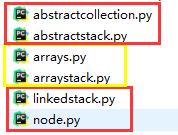本文实例讲述了Python实现栈的方法。分享给大家供大家参考,具体如下:
前言
使用Python 实现栈。
两种实现方式:- 基于数组 - 数组同时基于链表实现
- 基于单链表 - 单链表的节点时一个实例化的node 对象
完整代码可见GitHub:
https://github.com/GYT0313/Python-DataStructure/tree/master/5-stack目录结构:

注:一个完整的代码并不是使用一个py文件,而使用了多个文件通过继承方式实现。1. 超类接口代码
arraycollection.py
""" File: abstractcollection.py Author: Ken Lambert """ class AbstractCollection(object): """An abstract collection implementation.""" # Constructor def __init__(self, sourceCollection = None): """Sets the initial state of self, which includes the contents of sourceCollection, if it's present.""" self._size = 0 if sourceCollection: for item in sourceCollection: self.add(item) # Accessor methods def isEmpty(self): """Returns True if len(self) == 0, or False otherwise.""" return len(self) == 0 def __len__(self): """Returns the number of items in self.""" return self._size def __str__(self): """Returns the string representation of self.""" return "[" + ", ".join(map(str, self)) + "]" def __add__(self, other): """Returns a new bag containing the contents of self and other.""" result = type(self)(self) for item in other: result.add(item) return result def __eq__(self, other): """Returns True if self equals other, or False otherwise.""" if self is other: return True if type(self) != type(other) or \ len(self) != len(other): return False otherIter = iter(other) for item in self: if item != next(otherIter): return False return Trueabstractstack.py
""" File: abstractstack.py Author: Ken Lambert """ from abstractcollection import AbstractCollection class AbstractStack(AbstractCollection): """An abstract stack implementation.""" # Constructor def __init__(self, sourceCollection = None): """Sets the initial state of self, which includes the contents of sourceCollection, if it's present.""" AbstractCollection.__init__(self, sourceCollection) # Mutator methods def add(self, item): """Adds item to self.""" self.push(item)2. 基于数组
运行示例:

代码:
栈实现:arraystack.py""" File: abstractstack.py Author: Ken Lambert """ from abstractcollection import AbstractCollection class AbstractStack(AbstractCollection): """An abstract stack implementation.""" # Constructor def __init__(self, sourceCollection = None): """Sets the initial state of self, which includes the contents of sourceCollection, if it's present.""" AbstractCollection.__init__(self, sourceCollection) # Mutator methods def add(self, item): """Adds item to self.""" self.push(item)数组实现:arrays.py
""" File: arrays.py An Array is a restricted list whose clients can use only [], len, iter, and str. To instantiate, use <variable> = array(<capacity>, <optional fill value>) The fill value is None by default. """ class Array(object): """Represents an array.""" def __init__(self, capacity, fillValue = None): """Capacity is the static size of the array. fillValue is placed at each position.""" self._items = list() for count in range(capacity): self._items.append(fillValue) def __len__(self): """-> The capacity of the array.""" return len(self._items) def __str__(self): """-> The string representation of the array.""" return str(self._items) def __iter__(self): """Supports iteration over a view of an array.""" return iter(self._items) def __getitem__(self, index): """Subscript operator for access at index.""" return self._items[index] def __setitem__(self, index, newItem): """Subscript operator for replacement at index.""" self._items[index] = newItem3. 基于链表
运行示例:

代码:
linkedstack.py""" linkedstack.py """ from node import Node from abstractstack import AbstractStack class LinkedStack(AbstractStack): """基于单链表实现栈-链表头部为栈顶""" def __init__(self, source_collection=None): self._items = None AbstractStack.__init__(self, source_collection) def __iter__(self): """迭代-使用一个列表实现, 列表第一项为单链表的最后一项""" def visit_nodes(node): if node != None: visit_nodes(node.next) temp_list.append(node.data) temp_list = [] visit_nodes(self._items) return iter(temp_list) def peek(self): """返回栈顶元素""" self._prior_condition() return self._items.data def clear(self): """清空列表""" self._size = 0 self._items = None def push(self, item): """入栈""" self._items = Node(item, self._items) self._size += 1 def pop(self): """出栈""" self._prior_condition() old_item = self._items.data self._items = self._items.next self._size -= 1 return old_item def _prior_condition(self): if self._size == 0: raise KeyError("The stack is empty.")node.py
""" 链表结构的节点类 """ class Node(object): def __init__(self, data, next=None): self.data = data self.next = next参考:《数据结构(Python语言描述)》
希望本文所述对大家Python程序设计有所帮助。
-
<< 上一篇 下一篇 >>
Python实现栈的方法详解【基于数组和单链表两种方法】
看: 1253次 时间:2020-08-12 分类 : python教程
- 相关文章
- 2021-12-20Python 实现图片色彩转换案例
- 2021-12-20python初学定义函数
- 2021-12-20图文详解Python如何导入自己编写的py文件
- 2021-12-20python二分法查找实例代码
- 2021-12-20Pyinstaller打包工具的使用以及避坑
- 2021-12-20Facebook开源一站式服务python时序利器Kats详解
- 2021-12-20pyCaret效率倍增开源低代码的python机器学习工具
- 2021-12-20python机器学习使数据更鲜活的可视化工具Pandas_Alive
- 2021-12-20python读写文件with open的介绍
- 2021-12-20Python生成任意波形并存为txt的实现
-
搜索
-
-
推荐资源
-
Powered By python教程网 鲁ICP备18013710号
python博客 - 小白学python最友好的网站!